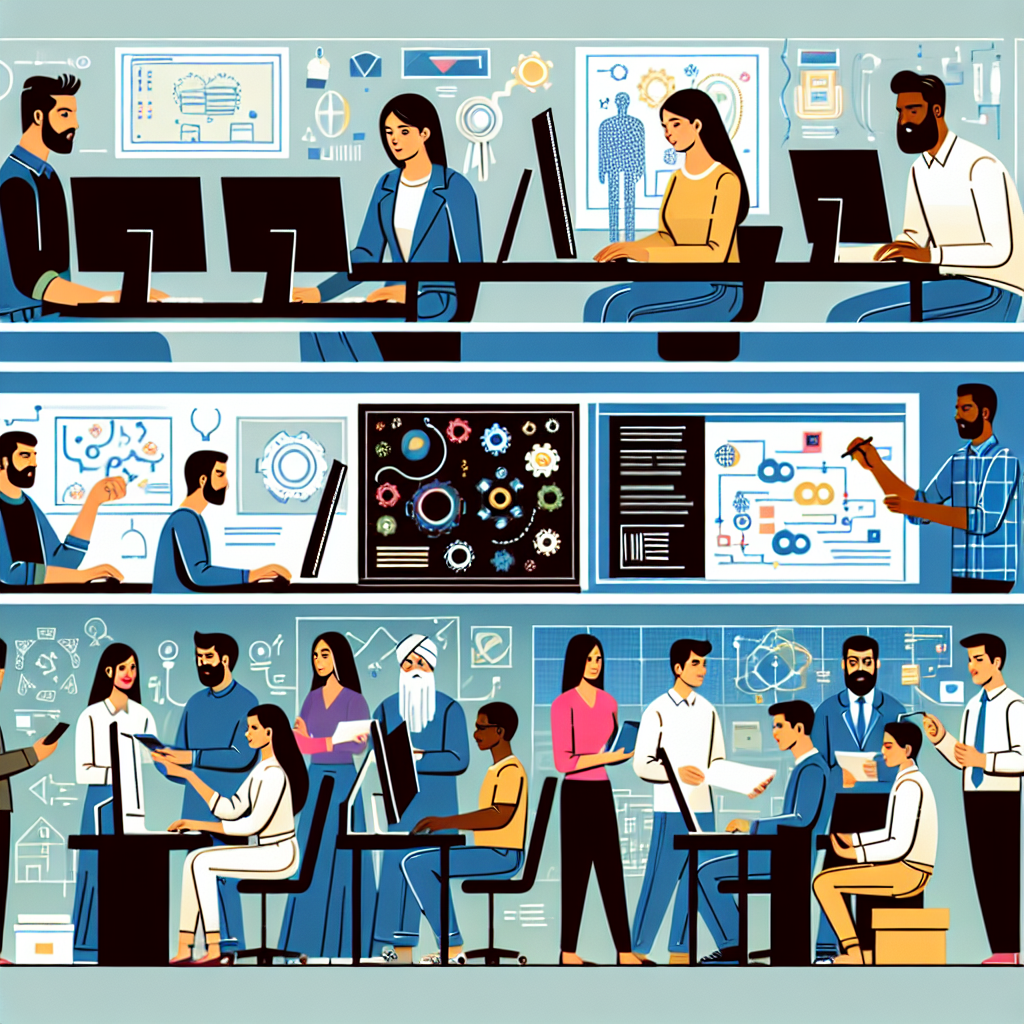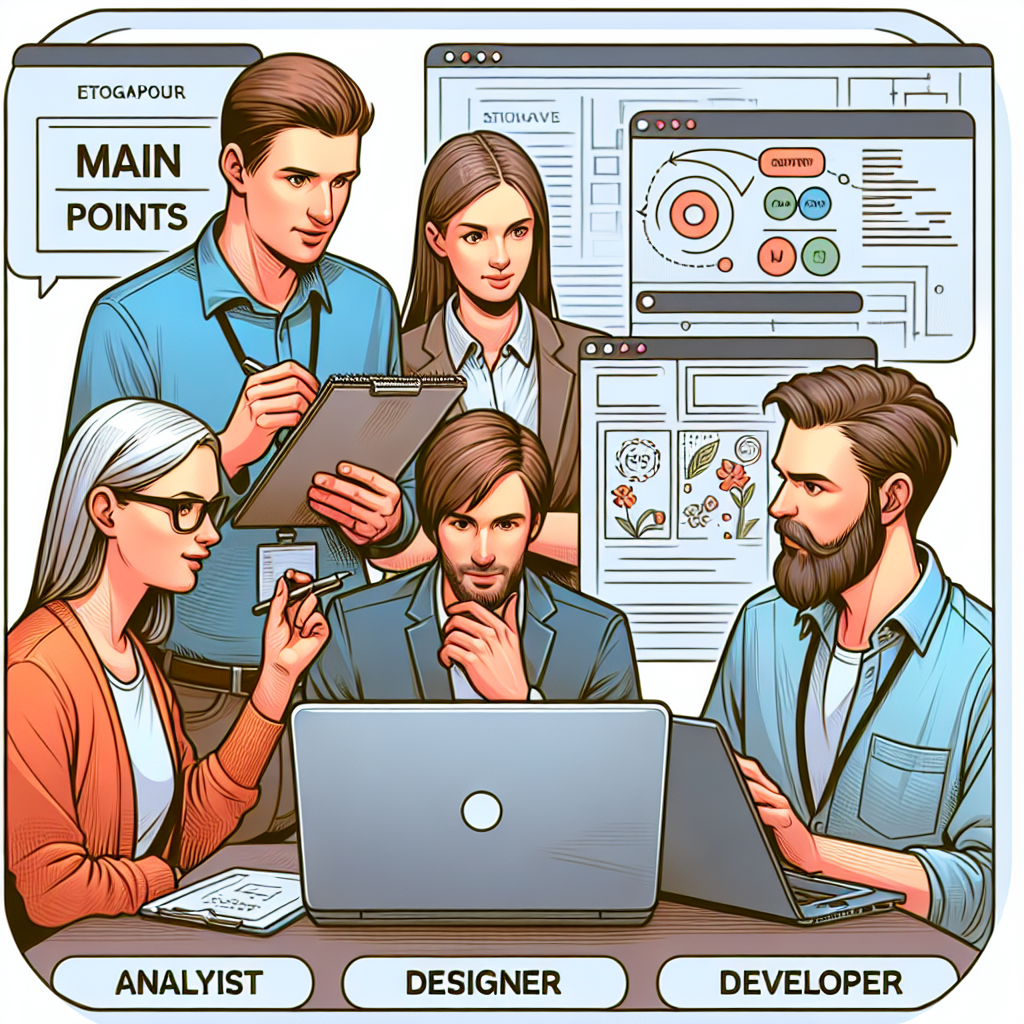Why is Software Design Necessary? Unveiling Its Impact on Business Success
Software design is not just an optional step in the development process; it is the backbone of your project’s success! ⭐ If youve ever wondered why software design is necessary, the answer is simple: great design leads to better functionality, user satisfaction, and ultimately, higher returns on investment.
Imagine you’re a business owner who just launched a new product. You’re excited, but then you realize your app crashes often and customers complain about usability. That’s where software design comes into play. Proper software design ensures that your application runs smoothly and meets your users needs. Don’t let poor design take the wind out of your sails!
The Role of Software Design in Achieving Success
- ⭐ Enhanced User Experience: Software design focuses on creating an intuitive interface, making it easy for your customers to navigate.
- ⭐ Efficiency: A well-designed application saves time and resources, both for users and developers.
- ⭐ Scalability: Great design allows for seamless updates and feature enhancements, making your software adaptable as your business grows.
A survey revealed that 86% of buyers are willing to pay more for a better user experience! Isnt that incredible? If your software provides a user-friendly interface, youre more likely to retain customers and boost sales. ⭐
So, how is software created? Here’s a quick breakdown of the software development lifecycle:
- ⭐ Planning: Identifying goals and requirements.
- ⭐️ Design: Creating wireframes and architectural blueprints.
- ⭐ Development: Coding and building the software.
- ⭐ Testing: Ensuring functionality and fixing bugs.
- ⭐ Deployment: Releasing the software to users.
- ⭐ Maintenance: Ongoing support and updates.
Client Story: The Impact of Software Design
Take the case of a local e-commerce business that was struggling with an outdated application. The owners reached out to us at webmaster.md. After a thorough analysis, we redesigned their software, focusing on user interface improvements and streamlined processes. Within months, their sales increased by 40%! ⭐ This transformation was made possible through effective software design, illustrating how necessary it is for business growth.
To maximize your investment in software, consider these expert tips:
- ⭐ Regular Updates: Software should be updated frequently to patch security vulnerabilities and enhance functionality.
- ⭐ Security Configuration: Always set up firewalls and encryption to protect sensitive data.
- ⭐️ User Feedback: Collect user feedback regularly to refine and enhance your application based on real-world use.
The statistics are clear—businesses that prioritize software design see up to a 50% increase in customer engagement! If youre an entrepreneur looking to grow, reaching out to professionals is essential.
At webmaster.md, we have 20 years of experience and a team of professional specialists ready to help you with all aspects of software design and development. ⭐ Call us today at +373 601 066 66 or visit us at webmaster.md to learn more about how we can assist you in achieving your business goals!
⭐ If youre ready to elevate your software to new heights, don’t wait! Contact Arsenii, our customer relations manager, today to discuss your project. We guarantee exceptional service that covers everything from software design to technical support—all in one place!
Frequently Asked Questions
- What is software design? It’s the process of defining the architecture, components, interfaces, and other characteristics of a system.
- Why is software design necessary? It ensures that the end product is user-friendly, functional, and scalable, leading to better user engagement.
- How is software created? Through stages including planning, design, development, testing, deployment, and maintenance.
- What is included in software development? Planning, design, implementation, testing, and maintenance of software applications.
- Who is involved in software design? Software architects, UI/UX designers, developers, and project managers play crucial roles.
- How often should software be updated? Regular updates, at least every few months, are recommended to enhance security and functionality.
- What happens if I skip proper software design? Users may face a poor experience, leading to decreased engagement and potential revenue loss.
- How can I ensure my software meets users needs? Gather user feedback during the design process and make necessary adjustments.
- Does good design really impact profitability? Absolutely! A well-designed software can enhance customer retention and lead to increased sales.
- How do I get started with software design? Reach out to a professional company like webmaster.md that offers comprehensive services—from design to deployment!
How is Software Created? The Step-by-Step Journey from Idea to Implementation
Creating software might seem like a daunting undertaking, but it’s a fascinating journey that transforms an idea into reality! ⭐ Understanding the process of how software is created can help you grasp the intricacies involved from ideation to launch.
Software development is an art that typically unfolds in several key phases. Let’s break it down step-by-step:
- ⭐ Idea and Planning: Every great software starts with a unique idea. During this phase, stakeholders identify problems to solve or needs to address. This is also when a project roadmap is created, outlining objectives, timelines, and required resources.
- ⭐️ Design: In this crucial step, developers and designers collaborate to create wireframes and user interface designs. This visual representation of the software helps in understanding the user experience and flow.
- ⭐ Development: Time to get coding! Developers write the actual code to build the software according to the specifications and designs provided, turning ideas into functional applications.
- ⭐ Testing: After development comes rigorous testing. This stage identifies bugs and issues, ensuring the software operates as intended. Different types of testing, including unit testing, integration testing, and user acceptance testing, are performed here.
- ⭐ Deployment: Once testing is successful, the software is deployed to the production environment. This means its now accessible to users!
- ⭐ Maintenance: The journey doesn’t end after deployment. Continuous maintenance involves monitoring performance, fixing bugs, and rolling out updates to enhance functionality based on user feedback.
Real-Life Example: Building a Business Application
Let’s consider a real-world scenario. A local retail business identified a repeating problem: managing inventory was chaotic. They reached out to us at webmaster.md to develop a tailored inventory management system. Here’s how we went through the steps:
- ⭐ Idea and Planning: We brainstormed with the client to define essential features, such as real-time tracking and automated restocking notifications. A project timeline was established.
- ⭐ Design: Our UI/UX designers created mockups that illustrated the application layout. Feedback from the client was incorporated to ensure the design aligned well with user expectations.
- ⭐⭐ Development: Our development team used agile methodologies to code the application in manageable sprints, ensuring continuous progress and regular updates to the client.
- ⭐️ Testing: After coding, we conducted various testing phases, including stress tests to ensure the application could handle fluctuations in inventory during peak sales periods.
- ⭐ Deployment: With successful testing, we launched the application live, ensuring a smooth transition from their old management methods.
- ⭐ Maintenance: We established a support plan for ongoing maintenance, including regular updates and feedback cycles to improve the application continuously.
Essential Tools and Technologies Used in Software Creation
Many tools and technologies are employed in the software development process. Here’s a quick overview:
| Category | Tools/Technologies |
| Project Management | Jira, Trello, Asana |
| Design | Sketch, Figma, Adobe XD |
| Development | Python, Java, JavaScript |
| Testing | JUnit, Selenium, Postman |
| Deployment | AWS, Azure, Google Cloud |
| Version Control | Git, GitHub, Bitbucket |
Understanding these stages and tools is crucial for anyone looking to foster innovation through software development. Every step has its own importance, and executing them effectively is what leads to the creation of a robust application.
Call to Action
So, if you’re considering developing software to solve your business challenges, why not start your journey with us? At webmaster.md, we bring 20 years of experience, ensuring every stage from idea to implementation is executed seamlessly. ⭐ Contact us at +373 601 066 66 or visit webmaster.md to learn how we can help you turn your ideas into reality!
What is Included in Software Development? Essential Components You Should Know
When diving into software development, it’s important to understand the essential components that make up the complete process. Knowing what to expect not only helps in setting realistic goals but also facilitates effective communication with your development team. Let’s take a closer look at the various elements involved in software development. ⭐️
Core Components of Software Development
Every successful software project encompasses several critical components. Here’s a detailed breakdown:
- ⭐ Requirements Gathering: This is the foundation of any project. It involves collecting and analyzing the needs of stakeholders to outline what the software must achieve. Without clear requirements, the development process can veer off track.
- ⭐ Design: In this stage, designs are created based on the gathered requirements. This includes both UI (User Interface) and UX (User Experience) design, where attention is given to how users will interact with the software.
- ⭐ Development: During this phase, developers start writing the code that brings the software to life. The choice of programming language and frameworks can vary based on project specifications. Popular languages include Python, Java, and JavaScript.
- ⭐ Testing: One cannot underestimate the importance of thorough testing. This component identifies bugs and issues before the software is released to users. Different testing techniques like unit testing, integration testing, and performance testing are employed during this phase.
- ⭐ Deployment: Once testing is completed successfully, the software is deployed in a live environment. This can involve configuring servers, ensuring compatibility, and user training.
- ⭐ Maintenance: Post-launch, continual maintenance is essential for keeping the software running smoothly and securely. This includes updates, bug fixes, and incorporating new features based on user feedback.
Real-World Example: Developing a Functional App
To illustrate these components, let’s discuss how we worked with a local health care provider. They required a patient management system to streamline operations. Here’s how we tackled each component:
- ⭐️ Requirements Gathering: We held workshops with medical staff to understand their real-time needs and challenges. What features did they need most? What issues were they facing with their current systems?
- ⭐ Design: Our design team created user-friendly mockups focused on accessibility and efficiency. We prioritized easy navigation for both staff and patients.
- ⭐ Development: Our developers adopted an agile methodology, allowing continuous collaboration with the client during coding to adapt to any changing needs.
- ⭐ Testing: Extensive testing was undertaken to ensure patient data security and software reliability. User acceptance testing was conducted with health staff to get their feedback before launching.
- ⭐ Deployment: The application was launched after a seamless migration of existing patient data, minimizing disruption to healthcare services.
- ⭐ Maintenance: We established a dedicated support team for ongoing maintenance, ensuring prompt responses to any issues that arose post-deployment.
Technology Stack in Software Development
An essential component of software development is the technology stack—the set of technologies used to build and run an application. Here’s a quick overview of a typical stack:
| Layer | Technologies |
| Frontend (Client-side) | HTML, CSS, JavaScript, React, Angular |
| Backend (Server-side) | Node.js, Ruby on Rails, Django, Java |
| Database | MySQL, PostgreSQL, MongoDB, Firebase |
| Hosting | AWS, Azure, Google Cloud |
| Version Control | Git, GitHub, Bitbucket |
Selecting the right technology stack is crucial as it impacts the application’s performance, scalability, and ease of future updates. ⭐
Call to Action
Now that you have a deeper understanding of what is included in software development, are you ready to take the leap? Whether youre launching a startup or enhancing existing solutions, webmaster.md is here to assist you every step of the way! With 20 years of experience and a full range of services, we can guide you through all phases of development. ⭐ Don’t hesitate to contact us at +373 601 066 66 or visit webmaster.md to kickstart your project!
Who is Involved in Software Design? Meet the Key Players Behind Successful Projects
Creating effective software isnt a one-person job; it takes a team of skilled professionals to bring an idea to life! ⭐ Understanding the key players involved in software design is essential for anyone looking to embark on a development journey. Let’s break down who these individuals are and the unique roles they play in ensuring project success.
Meet the Key Players in Software Design
- ⭐⭐ Software Architect: The visionary behind the software project! A software architect designs the high-level structure of the software, making crucial decisions on technologies, frameworks, and components. Their expertise is vital for ensuring that the software is scalable, reliable, and maintains high performance.
- ⭐ UI/UX Designer: Focusing on the user’s experience, UI (User Interface) and UX (User Experience) designers create visually appealing and intuitive designs. Their job is to ensure that users can interact with the software effortlessly, making it not only functional but also enjoyable to use.
- ⭐ Frontend Developer: These developers are responsible for building the client-side of the application—the part users interact with. Proficient in languages like HTML, CSS, and JavaScript, frontend developers translate design mockups into actual code.
- ⭐ Backend Developer: Working behind the scenes, backend developers are responsible for creating the server-side logic and database interactions. They ensure that data flows smoothly between the server and the client interface, maintaining the application’s core functionality.
- ⭐ QA Engineer: Quality Assurance (QA) Engineers rigorously test the software to identify bugs, usability issues, and performance bottlenecks. Their role is crucial in ensuring that the product is polished and ready for deployment.
- ⭐ Project Manager: The project manager oversees the entire software design process. They coordinate communication among team members, track progress, and ensure that the project stays within budget and schedule. Their leadership helps keep everyone aligned and focused on their goals.
- ⭐ DevOps Engineer: These professionals help bridge the gap between development and operations, streamlining processes and implementing CI/CD (Continuous Integration/Continuous Deployment) practices. They optimize the deployment process, ensuring that updates and maintenance are performed smoothly.
Lets consider a scenario where a company wants to develop a CRM system tailored to their sales teams needs. Here’s how each of these players would contribute:
- ⭐️ Software Architect: Designs the overall architecture of the CRM, ensuring it integrates with existing systems seamlessly.
- ⭐ UI/UX Designer: Creates user-friendly interfaces that make it easy for sales reps to log interactions and track customer data.
- ⭐ Frontend Developer: Implements the designs into code, making sure the application is responsive and intuitive.
- ⭐ Backend Developer: Structures the database for efficient data management and ensures all functionalities work correctly.
- ⭐ QA Engineer: Conducts extensive testing with actual sales reps to capture their feedback and iron out any issues before launch.
- ⭐ Project Manager: Keeps the project on task by coordinating meetings, updates, and adjusting timelines as needed.
- ⭐ DevOps Engineer: Prepares the infrastructure for deployment, ensuring the system is secure and easily maintainable.
Collaborative Tools Used in Software Design
Effective collaboration is key! Here are some tools that these professionals often use to ensure smooth communication and project progression:
| Tool Category | Common Tools |
| Project Management | Trello, Asana, Jira |
| Design | Figma, Sketch, Adobe XD |
| Development | Visual Studio Code, GitHub, Bitbucket |
| Testing | JUnit, Selenium, Postman |
| Communication | Slack, Microsoft Teams, Zoom |
These tools foster a collaborative environment where ideas can flow freely, and issues can be resolved quickly. ⭐
Call to Action
Are you ready to build a successful software project with a dedicated team of professionals? At webmaster.md, we have 20 years of experience and a team of experts specializing in every aspect of software design and development. ⭐ Reach out today at +373 601 066 66 or visit webmaster.md to turn your ideas into reality!






